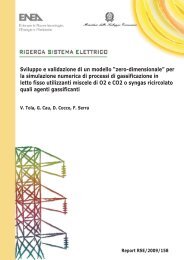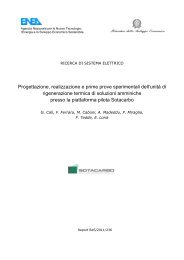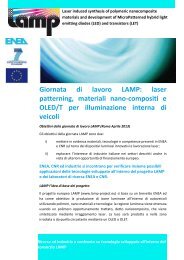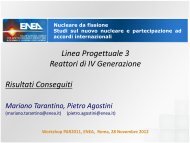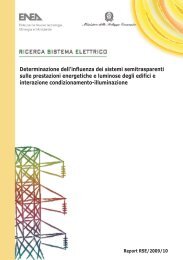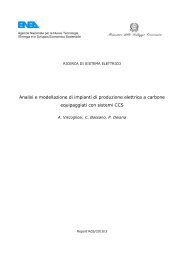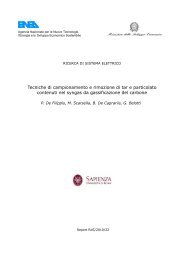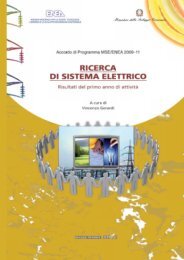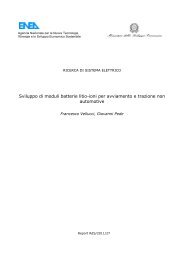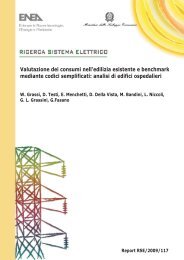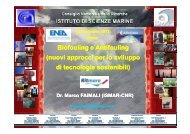- Page 1 and 2: Agenzia Nazionale per le Nuove Tecn
- Page 3 and 4: Inquadramento programmatico Il Pres
- Page 5 and 6: 1. Scopo del documento Il documento
- Page 7 and 8: Per quel che riguarda invece le reg
- Page 9 and 10: Gli studi esaminati risultano purtr
- Page 11 and 12: Figura 1: Batterie prodotte da Hipo
- Page 13 and 14: N.4 Celle BMS Elettricità Produzio
- Page 15 and 16: I data sets primari costituiranno u
- Page 17 and 18: Litio ferro fosfato vedi Tabella 6
- Page 19 and 20: 5. Organizzazione dei data sets pri
- Page 21 and 22: 6. Valutazione degli impatti Il pro
- Page 23 and 24: Tabella 11: Consumo di energia prim
- Page 25 and 26: Tabella 13: Consumo di energia prim
- Page 27 and 28: 7. Interpretazione dei risultati I
- Page 29 and 30: 9. Bibliografia Boureima Fayçal-Si
- Page 31 and 32: Allegato 1 Schede dei dati raccolti
- Page 33 and 34: - Uso; - Fine vita. 32
- Page 35 and 36: 4. Metadati Unità funzionale (U.F.
- Page 37 and 38: Scheda N.2 1. Prodotto: Batteria al
- Page 39: Esaurimento di metalli (MDP) 0,85 [
- Page 44 and 45: Figura D: Confini del sistema Regol
- Page 46 and 47: Scheda N.5 1. Prodotto: 1) Batteria
- Page 48 and 49: Consumo di energia primaria (senza
- Page 50 and 51: Scheda N.8 1. Prodotto: Batteria ag
- Page 52 and 53: Scheda N.9 1. Prodotto: Batteria ag
- Page 54 and 55: Polipropilene:9 Polietilene:9 Parti
- Page 56 and 57: Scheda N.10 1. Prodotto: Veicolo el
- Page 59 and 60: WTT: well-to-tank (impatti dal pozz
- Page 61 and 62: 2. Quale è la provenienza della ma
- Page 63 and 64: Elenco dei macchinari utilizzati, d
- Page 65 and 66: Qual è la potenza dei macchinari i
- Page 67 and 68: 1. Quale è il consumo della materi
- Page 69 and 70: (2) kg/a 2.2 Qual è la produzione
- Page 71 and 72: QUESTIONNAIRE TO COLLECT DATA RELAT
- Page 73 and 74: Annual electricity consumption for
- Page 75: SALE OF THE PRODUCT 1 Percentage (%
- Page 78 and 79: Copper, 0.99% in sulfide, Cu 0.36%
- Page 80 and 81: TiO2, 54% in ilmenite, 2.6% in crud
- Page 82 and 83: Transformation, to dump site, inert
- Page 84 and 85: Formaldehyde Emission to air Furan
- Page 86 and 87: 1-Butanol Emission to air high. pop
- Page 88 and 89: Ethane, 1,1,2-trichloro-1,2,2-trifl
- Page 90 and 91:
Ozone Emission to air high. pop. µ
- Page 92 and 93:
Antimony Emission to air low. pop.
- Page 94 and 95:
Iodine-135 Emission to air low. pop
- Page 96 and 97:
Thorium Emission to air low. pop.
- Page 98 and 99:
Carbon dioxide, fossil Emission to
- Page 100 and 101:
Solved solids Emission to water Str
- Page 102 and 103:
BOD5, Biological Oxygen Demand Emis
- Page 104 and 105:
Chlorinated solvents, unspecified E
- Page 106 and 107:
2-Methyl-1-propanol Emission to wat
- Page 108 and 109:
Dimethylamine Emission to water riv
- Page 110 and 111:
Propylamine Emission to water river
- Page 112 and 113:
Oils, unspecified Emission to soil
- Page 114 and 115:
Magnesium Emission to soil industri
- Page 116 and 117:
Dolomite, in ground Resource in gro
- Page 118 and 119:
Volume occupied, final repository f
- Page 120 and 121:
Transformation, to forest, intensiv
- Page 122 and 123:
Hydrocarbons, aliphatic, alkanes, u
- Page 124 and 125:
2-Aminopropanol Emission to air hig
- Page 126 and 127:
Ethene, chloro- Emission to air hig
- Page 128 and 129:
Pentane Emission to air high. pop.
- Page 130 and 131:
Barium Emission to air low. pop. mg
- Page 132 and 133:
Krypton-87 Emission to air low. pop
- Page 134 and 135:
Tin Emission to air low. pop. mg 22
- Page 136 and 137:
Ethylene oxide Emission to air stra
- Page 138 and 139:
Thallium Emission to water Tin, ion
- Page 140 and 141:
Chloride Emission to water groundwa
- Page 142 and 143:
Cyanide Emission to water ocean mg
- Page 144 and 145:
Acetaldehyde Emission to water rive
- Page 146 and 147:
Ethene Emission to water river mg 3
- Page 148 and 149:
Radium-224 Emission to water river
- Page 150 and 151:
Aldrin Emission to soil agricultura
- Page 152 and 153:
Silicon Emission to soil industrial
- Page 154 and 155:
Dolomite, in ground Resource in gro
- Page 156 and 157:
Volume occupied, final repository f
- Page 158 and 159:
Transformation, to forest, intensiv
- Page 160 and 161:
Hydrocarbons, aliphatic, alkanes, u
- Page 162 and 163:
2-Aminopropanol Emission to air hig
- Page 164 and 165:
Ethene, chloro- Emission to air hig
- Page 166 and 167:
Pentane Emission to air high. pop.
- Page 168 and 169:
Barium Emission to air low. pop. mg
- Page 170 and 171:
Krypton-87 Emission to air low. pop
- Page 172 and 173:
Tin Emission to air low. pop. mg 36
- Page 174 and 175:
Ethylene oxide Emission to air stra
- Page 176 and 177:
Thallium Emission to water Tin, ion
- Page 178 and 179:
Chloride Emission to water groundwa
- Page 180 and 181:
Cyanide Emission to water ocean g 1
- Page 182 and 183:
Acetaldehyde Emission to water rive
- Page 184 and 185:
Ethene Emission to water river mg 4
- Page 186 and 187:
Radium-224 Emission to water river
- Page 188 and 189:
Aldrin Emission to soil agricultura
- Page 190 and 191:
Silicon Emission to soil industrial
- Page 192 and 193:
Feldspar, in ground Resource in gro
- Page 194 and 195:
Volume occupied, final repository f
- Page 196 and 197:
Transformation, to forest, intensiv
- Page 198 and 199:
Hydrocarbons, aliphatic, unsaturate
- Page 200 and 201:
2-Butene, 2-methyl- Emission to air
- Page 202 and 203:
Ethene, tetrachloro- Emission to ai
- Page 204 and 205:
Phenol Emission to air high. pop.
- Page 206 and 207:
Barium-140 Emission to air low. pop
- Page 208 and 209:
Krypton-88 Emission to air low. pop
- Page 210 and 211:
Titanium Emission to air low. pop.
- Page 212 and 213:
Formaldehyde Emission to air strato
- Page 214 and 215:
Titanium, ion Emission to water TOC
- Page 216 and 217:
Cobalt Emission to water groundwate
- Page 218 and 219:
Fluoride Emission to water ocean mg
- Page 220 and 221:
Acetone Emission to water river ng
- Page 222 and 223:
Ethyl acetate Emission to water riv
- Page 224 and 225:
Radium-228 Emission to water river
- Page 226 and 227:
Antimony Emission to soil agricultu
- Page 228 and 229:
Strontium Emission to soil industri
- Page 230 and 231:
Feldspar, in ground Resource in gro
- Page 232 and 233:
Volume occupied, final repository f
- Page 234 and 235:
Transformation, to forest, intensiv
- Page 236 and 237:
Hydrocarbons, aliphatic, unsaturate
- Page 238 and 239:
2-Butene, 2-methyl- Emission to air
- Page 240 and 241:
Ethene, tetrachloro- Emission to ai
- Page 242 and 243:
Phenol Emission to air high. pop.
- Page 244 and 245:
Barium-140 Emission to air low. pop
- Page 246 and 247:
Krypton-88 Emission to air low. pop
- Page 248 and 249:
Titanium Emission to air low. pop.
- Page 250 and 251:
Formaldehyde Emission to air strato
- Page 252 and 253:
Titanium, ion Emission to water TOC
- Page 254 and 255:
Cobalt Emission to water groundwate
- Page 256 and 257:
Fluoride Emission to water ocean mg
- Page 258 and 259:
Acetone Emission to water river ng
- Page 260 and 261:
Ethyl acetate Emission to water riv
- Page 262 and 263:
Radium-228 Emission to water river
- Page 264 and 265:
Antimony Emission to soil agricultu
- Page 266 and 267:
Strontium Emission to soil industri



